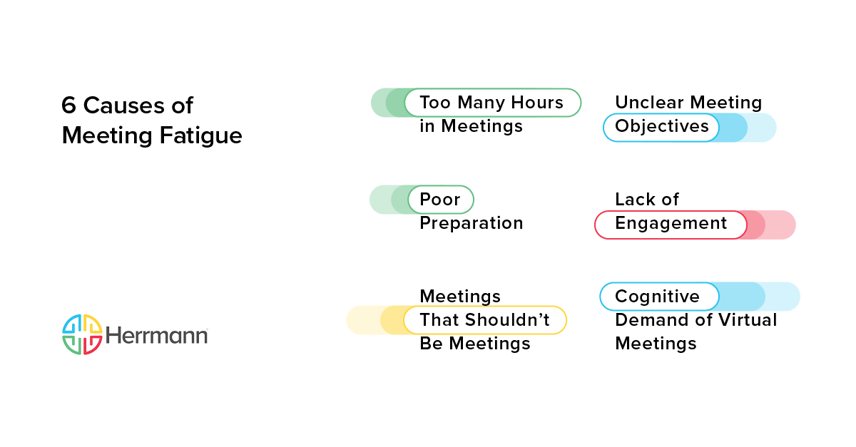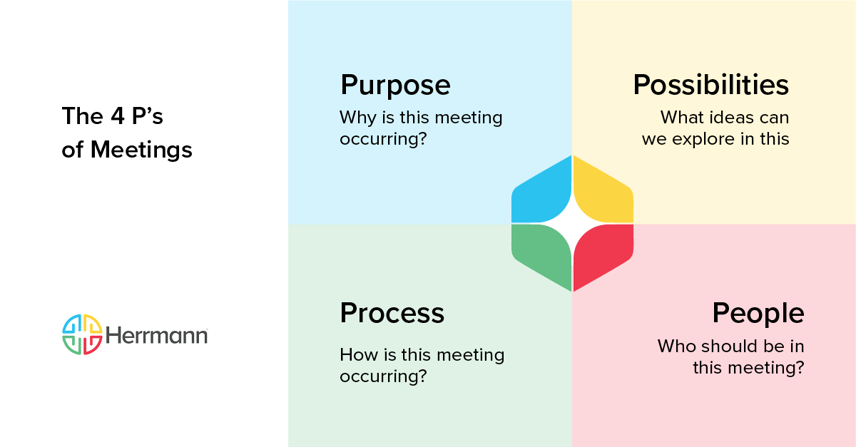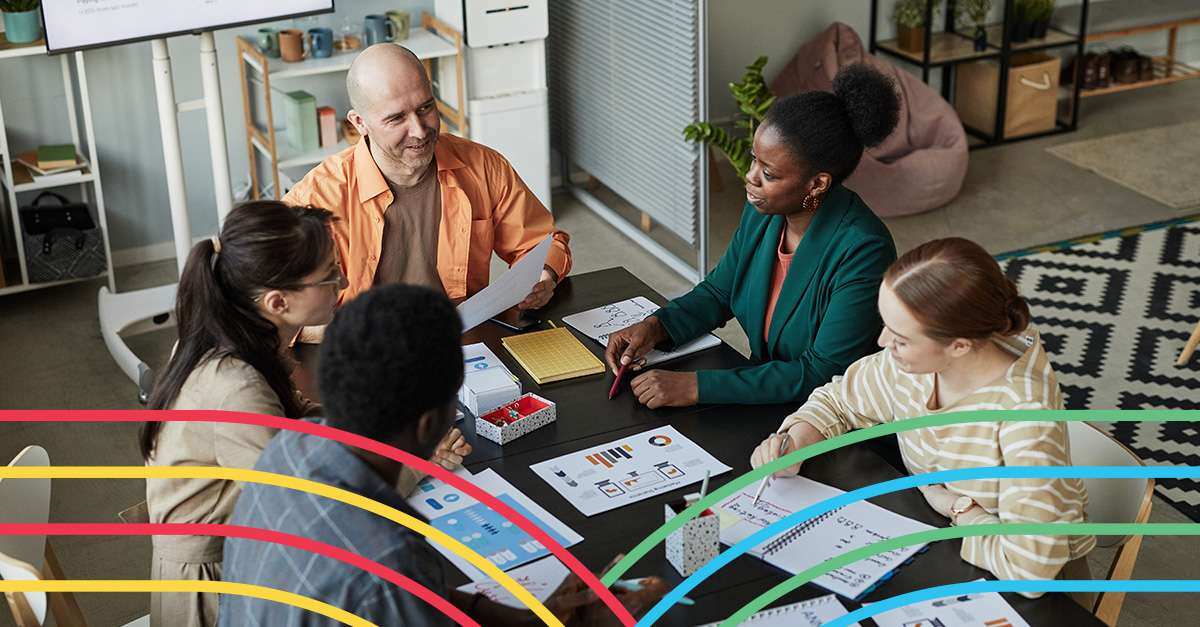We have all been there: sitting in back-to-back meetings, feeling drained and overwhelmed. This phenomenon is so common that it has a name — meeting fatigue. It’s a serious issue that can reduce productivity, lower employee motivation, and drive burnout.
Meetings have always been challenging to get right, but what’s changed in the past few years is the heavy use of video. Virtual meeting fatigue affects 95% of employees, according to Webex data. Separate research from Microsoft found that some workers spend up to eight hours each week in Microsoft Teams meetings and calls — which doesn’t include other meetings!
Fortunately, leaders can address this problem within their teams when they understand the causes of meeting fatigue and how to prevent them. Learn more about how meeting fatigue manifests and how Whole Brain® Thinking can make your team’s interactions more productive and energizing.
What Is Meeting Fatigue?
Meeting fatigue is a phenomenon that affects workers who attend too many virtual, remote, or in-person meetings. Meeting fatigue occurs when people feel overwhelmed from excessive, overly long, or unnecessary meetings. Anxiety, stress, or other adverse effects commonly result.
The effects of meeting fatigue can be far-reaching and damaging if left unchecked. Too many meetings can increase stress and cognitive load, while poorly run meetings harm productivity and decision-making.
Having too many meetings per day or week is an obvious form of meeting fatigue. But how your meetings are scheduled also matters. A block of meetings can be less disruptive than having only short breaks between meetings that don’t allow for any deep, head-down thinking.
6 Causes of Meeting Fatigue
Meetings are an efficient and convenient way to gather people and make decisions, but there’s always the risk of overrelying on them. Here are some of the ways meeting fatigue manifests inside organizations.
Too Many Hours in Meetings
How long should a meeting take? There’s no one answer, but meetings can easily run too long because we (and our scheduling software) default to certain lengths of time — 30 or 60 minutes, for instance.
This cause of meeting fatigue can manifest in a couple of ways. One is the sheer accumulation of meetings, where employees struggle to muster focus and engagement as their energy drains. Another cause is when meetings are unnecessarily long or don’t allow for breaks. Spending hours on topics that could have taken minutes will result in disengagement and even burnout for your team. Employees might also become less engaged with other meetings because they expect the worst.
Unclear Meeting Objectives
Meetings take time and concentration, particularly when focusing on a screen. But that energy is wasted when a meeting has no clear purpose or goal. Furthermore, without a clear objective in place, there may be excessive time spent discussing irrelevant topics or going on tangents.
Every meeting should have clarity on who should attend, what will be discussed, what decisions will be made, and what should happen next. If your meetings lack these elements, they’ll likely be less effective.
Lack of Engagement
Unfocused meetings tend to result in a lack of engagement, often because participants feel disconnected from the proceedings. Perhaps they’re already tired and unwilling to inquire why they’re even at your meeting. Maybe this meeting’s not relevant to them — and the right person wasn’t invited.
Another way employees become disengaged in meetings is when they don’t receive opportunities to contribute. Meetings dominated by the leader or a few loud voices could discourage other attendees from speaking up. Even worse, they might become frustrated and disengaged because they don’t believe their voice matters.
When meeting participants aren’t engaged, they’re less likely to pay attention or contribute positive feedback and ideas. This lack of cognitive differences could result in poor decision-making and further disengagement.
Poor Preparation
Inadequate preparation also can lead to meeting fatigue. This manifests in a few common ways. One is when the organizer fails to schedule a meeting or isn’t clear about the time or place. Confusion about the time or place of the meeting, who’s invited, or what’s on the agenda can cause frustration and confusion.
Participants also need to prepare. You’ve probably been to meetings where someone derails the conversation because they ask questions already covered by the prep materials. Similarly, people who attend meetings late are disruptive and can waste time getting caught up. When you’re not prepared, for whatever reason, you can’t bring your best self to the meeting — and that effect could carry into the rest of your day.
Meetings That Shouldn’t Be Meetings
Some meetings could be an email, a quick phone call, or a shared document. Consider a standing meeting where there’s not much movement since the last gathering. That meeting could be postponed or canceled, with team members giving status updates in another channel.
Unnecessary meetings keep employees from getting to more important tasks and potentially cause them to disengage from all meetings. Stress and frustration can result when employees feel like their time is wasted.
Cognitive Demand of Virtual Meetings
Virtual meetings are increasingly conducted with video as a default instead of just a phone call. Video chats can be more cognitively intense than face-to-face conversations. Our brains must work harder to interpret other participants’ facial expressions, especially when users view each other on relatively small laptop and smartphone screens. Remote working fatigue is one consequence for many employees who endure video calls that used to be in-person meetings or casual conversations.
Meeting technology creates tremendous benefits by connecting remote workers to their colleagues around the world, but it’s not flawless. Poor internet connections, bad sound, and other distractions all can make the meeting experience less comfortable and add stress.

How to Prevent and Reduce Meeting Fatigue
Meeting fatigue is a common problem for many teams in the workplace. The good news is that by following some practical strategies, you can reduce or prevent it. Here are a few tips teams can use to reduce meeting fatigue:
Set an Agenda
The meeting organizer should send out an agenda before each meeting, whether in a separate communication or attached to the invite. This agenda should have specific topics of discussion and will often mention the decisions to be made.
This information helps invited participants understand what will be discussed so they can prepare — or decline to attend if the topic isn’t relevant. During the meeting, the agenda can help keep everyone on task and on schedule.
Leverage Technology
Your company probably uses a variety of technologies. Regularly assess whether your technology facilitates effective remote meetings rather than making them more complicated. Make sure every employee has access to the same meeting software, for example, and has the right hardware setup to effectively participate — including their camera and microphone.
Take advantage of virtual assistants that will automatically record and summarize meetings. This creates a record for anyone who needs to check what was discussed, even if they couldn’t attend live.
Encourage Feedback
Leaders don’t always know when a meeting has become unproductive or a waste of time. They need a team culture where feedback and suggestions are welcomed — even when that feedback isn’t easy to hear. Team meeting ideas can come from anywhere, not just leadership.
The only way to get such honest feedback is to build a psychologically safe workplace where people’s differences are embraced, not ridiculed or punished. If employees are overwhelmed by poorly run or unnecessary meetings, they won’t speak up unless they feel their feedback will be respected — and acted upon. As a leader, make sure you explain how you respond to meeting-related feedback and what changes will result.
Allow for Breaks During Long Meetings
Some meetings are designed to be longer — a daylong strategic retreat, for example. However, a long meeting without stoppages will cause frustration and impatience and contribute to rushed or ill-tempered decision-making.
Consider a 15-minute break every 60 to 90 minutes, for example, so people can stretch their legs, use the restroom, or simply reflect. Full-day meetings should include time for meals or even a longer break (two to three hours) for employees to recharge or tend to other matters.
Those breaks aren’t lost productivity. Rather, they help people replenish themselves and return to the meeting with renewed focus.
Make Meetings Harder to Schedule
Shopify famously canceled recurring meetings, blocked off Wednesdays on the calendar, and restricted when large gatherings could occur. The company enacted a cultural shift to scrutinize meetings as a cost that must be justified.
Consider meeting-free days that apply to departments or even the whole organization. Have managers encourage employees to create meeting-free blocks in their schedule for deep thinking. At a higher level, audit your company’s existing meetings to see what’s truly necessary and what could be communicated in another way.

How Whole Brain® Thinking Can Improve Team Meetings
Meetings are effective when they have a clear purpose, are well-organized, and embrace the differences of perspectives within your team.
A team with cognitive differences is built on the idea that every person has something to contribute because of their background, experience, and thought processes. One of the best ways to build cognitive differences within your team is to implement the Whole Brain® Thinking framework, including having employees take the Herrmann Brain Dominance Instrument (HBDI®) assessment.
The HBDI® Assessment helps leaders and individuals identify and understand their preferred thinking processes within the Whole Brain® Thinking framework. The framework contains four quadrants representing different thinking preferences: Analytical (Blue), Structural (Green), Relational (Red), and Experimental (Yellow).
People access and use each quadrant in their daily thinking, but they’re more inclined to one or two quadrants. There are no “best” thinking preferences or a combination thereof.
One way to apply Whole Brain® Thinking to better meetings is to consider the 4 P’s: purpose, process, people involved, and possibilities.
Purpose
Meeting fatigue is much less likely to occur when employees attend productive meetings with open discussion and clear action items.
One of the easiest ways to reduce excess meetings is to ask this direct question: “What do we hope to accomplish with this meeting?” Whether it’s to approve a business deal, engage in collaborative brainstorming, or deliver important team updates, the leader needs to be clear about the meeting’s purpose.
Analytical (Blue) thinkers are logical and quantitative. They can quickly assess whether a meeting has clear objectives, decision points, or intended outcomes. If your meeting is more of a status update, such as the announcement of a decision, consider whether another communication method is best.
Be wary of placeholder meetings — when you think you might have something to discuss, don’t simply throw it on the calendar. Doing this is a sure-fire way to increase your number of meetings and add stress to your team.
Process
Don’t leave meetings to chance. Let’s return to the purpose: How do you decide what should be a meeting and what could be an email, group chat, or one-on-one discussion? A meeting decision tree can serve as a simple, anxiety-easing way for team members to know when to ask for a meeting (or not).
Meeting fatigue can be reduced simply by having meetings that start and end on time, allowing participants to move on with their days. Don’t underestimate the power of predictability.
How you run your meetings also is about process. Make sure every employee has the software and communication tools to be aware of meetings and fully participate. This type of organization and attention to detail is the hallmark of Practical (Green) thinkers. Project managers, for example, are likely to have a strong preference for the Green quadrant of Whole Brain® Thinking.
People
Meetings are ultimately about people coming together to get more done than they could alone. Relational (Red) thinkers are especially attentive to these interpersonal issues, and the emotions that can arise when people feel included — or excluded — from team conversations.
Start with the invite list. Have you asked the right people to join your meeting — and only the right people? Does everyone have the materials and information they need to contribute at their best?
Remember the user experience, especially for work-from-home employees joining an on-site meeting. These remote employees experience the meeting differently over audio or video, and they can inadvertently be excluded. If remote attendees can’t see visuals or struggle to listen in on side conversations, for example, they’ll contribute less and withdraw emotionally.
Possibilities
Innovative teams need to be able to explore ideas without judgment and without fear of being punished for failure. To be truly collaborative, your employees must trust their teammates enough to be vulnerable. Achieving this state is easier when teams understand the power of cognitive differences.
Good meetings are well-organized and focused, but they also leave room for hope and imagination, especially when the meeting is future-facing. By unlocking your Experimental (Yellow) thinkers to explore potential improvements, solutions, and outcomes, you set the foundation for more innovative and effective action. Meeting fatigue is reduced, meanwhile, because your team is energized to take on problems.
Put Energy Back Into Your Meetings
As organizations try to figure out the new normal of remote and hybrid work, meeting fatigue is all too common. Address this problem by understanding what goes into a good meeting and by being bold enough to experiment with better and fewer meetings.
As you audit your meeting culture, consider how the 4 P’s can help you improve meetings while considering every employee’s preferred thinking preferences.
Want to learn more? Get our free toolkit to create team meetings that work.


.png?width=1318&name=X-Steps-to-Overcoming-Meeting-Fatigue%20(1).png)










